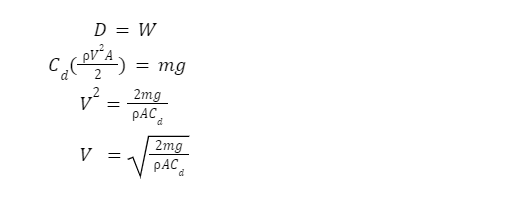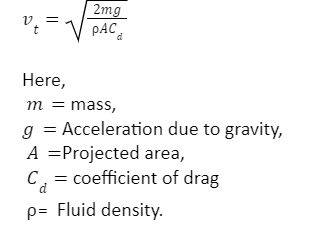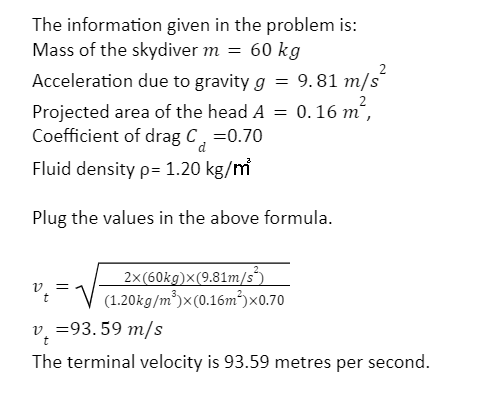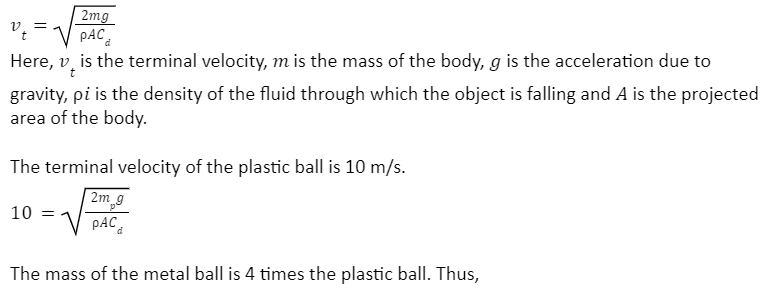Ever wonder why a golf ball falls faster than a beach ball? The terminal velocity explains the concept that an object with a smaller cross-sectional area falls faster than the object with a low cross-sectional area. Terminal velocity of the object is the highest velocity it gains when it is falling through a fluid (gas or liquid). The application of terminal velocity is found in fluid mechanisms.
An object reaches the terminal velocity when the resisting force of fluid (drag force) becomes equal to the driving force of the object. This is the position where acceleration of the object becomes zero and the object falls with constant vertical velocity or terminal velocity.
Definition and Formula of Terminal Velocity
Terminal velocity is the highest speed at which a body falls through a fluid (gas or liquid). The formula used to find the terminal velocity of a body is expressed below.
vt=√2mg/ √ρACd
Here, vt is the terminal velocity, m is the mass of the body, g is the acceleration due to gravity, ρi is the density of the fluid through which the object is falling and A is the projected area of the body.
Derivation of Terminal Velocity
There are two external forces acting on an object which is falling through the fluid. Ond force is gravitational force and another force is drag force.
Gravitational Force: The gravitational force which is exerted as the weight of the object. This force is equal to the product of mass of the falling object and the gravitational acceleration.
W=mg
Here, W is the weight of the object, m is the mass of the object and a is the acceleration.
Drag Force: Drag force is the force exerted by the fluid stream on the object which is falling through it. Drag equation is expressed with the help of the following expression:
D=Cd ρV2A/2
Here, D is the drag, Cd is the drag coefficient, ρ density of the fluid, V is the velocity and A is the area projected by the object.
The value of drag increases with the square of the velocity of the object. For the terminal velocity, the object reaches the maximum velocity and the acceleration becomes equal to zero. With zero vertical acceleration, the constant vertical velocity of the object is called the terminal velocity.
For this case the drag becomes equal to weight and there is no external force now acting on the object. At terminal velocity, the net force becomes equal to zero.
This is the required terminal velocity.

Example
1. A 60 kg skydiver is falling towards the surface of Earth. The head of the skydiver is in the downward direction with cross-sectional area 0.16 m2. The coefficient of drag is 0.70 and the density of the air is 1.20 kg/㎥. Find the value of terminal velocity.
Ans: The terminal velocity of the skydiver can be found using the following formula.


- For a free-falling plastic ball, the value of its terminal velocity is 10 m/s. This ball is changed with the metal ball having the time mass than the plastic while all other factors are the same. What is the terminal velocity of a metal ball?
Ans: The terminal velocity of the body is proportional to the square root of its mass. The plastic ball is changed with the metal ball. As the mass of the metal ball is more compared to the plastic ball. Its terminal velocity is increased.
The formula used to find the terminal velocity of a body is:


Conclusion
The terminal velocity is an important concept used in fluid mechanics. In case of terminal velocity of a body, the change in velocity is terminated by the balance of drag force and driving force.
Terminal velocity is a steady speed achieved by a body while free falling through a fluid. It is obtained when the speed of a body, which is in motion, is neither increasing nor decreasing.
 Profile
Profile Settings
Settings Refer your friends
Refer your friends Sign out
Sign out




